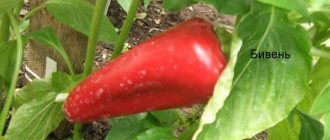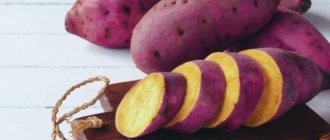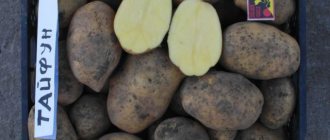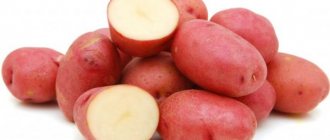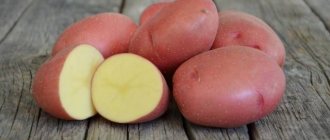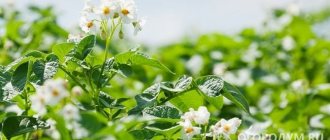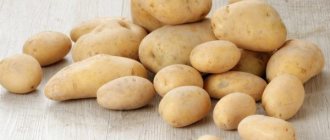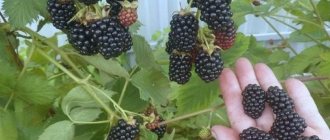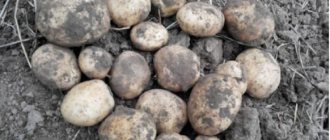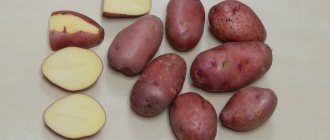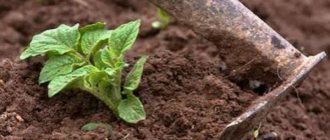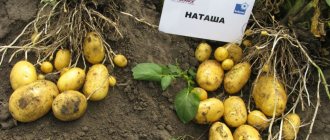Vegetable growing » Potatoes
0
1909
Article rating
Kira Stoletova
Against the backdrop of rapidly changing weather conditions in the countries of central Europe and the former USSR, breeders were faced with the urgent question of developing a potato variety that has high yields and resistance to harsh climates. Breeders from Germany have achieved significant success in this matter. In particular, based on the results of breeding research, employees developed a variety called Laura potatoes. In terms of its qualities and characteristics, Laura fully complies with the required standards.
Potato variety Laura
Description of the variety Laura
| Variety name | Laura |
| general characteristics | mid-early table variety with beautiful pink tubers |
| Maturation period | 70-80 days |
| Starch content | 15-17% |
| Weight of marketable tubers | 90-150 gr |
| Number of tubers in a bush | up to 20 |
| Productivity | 332-520 c/ha |
| Consumer qualities | good taste, suitable for any dish |
| Keeping quality | 90% |
| Peel color | pink |
| Flesh color | yellow |
| Preferred Growing Regions | any black earth regions |
| Disease resistance | moderately resistant to all diseases and viruses |
| Features of cultivation | Additional watering is required |
| Originator | Europlant Pflanzenzucht GmbH (Germany) |
The Laura potato variety is a mid-early variety; the period from main shoots to technical maturity (potatoes have a dense skin and the required size) averages 80 days.
Potatoes can be consumed a little earlier than their technical maturity, when the tubers reach acceptable sizes and the thin skin is well preserved.
Early and mid-early varieties are planted mainly for the consumption of young potatoes.
Root vegetables with greenish spots (appear if the potatoes have been in the sun for some time) are not suitable for consumption, as they contain solanine, a toxic substance.
The root crop is:
- The peel is dense, smooth, dark pink.
- The eyes are medium in size, located without indentations.
- The shape is oblong, almost regular oval.
- Weight - from 90 g to 150 g, dimensions - from 7 cm in length.
- The color and structure of the pulp is rich yellow and dense.
- Starch content - 15-17%.
Reference. Potatoes with a starch content of 14% to 25% are considered “high-starchy”, which means they are tasty. Potatoes are valued for their starch content.
The bush is spreading, tall, large, erect. The leaves are intermediate in shape, typical in shape for potatoes, the structure is wrinkled, without pubescence, medium in size, dark green in color. There are many inflorescences. The corolla of flowers is mostly white, but light purple flowers are also often found.
Climatic growing zones
The most successful regions for cultivation in the Russian Federation are Central and Northwestern, and successful cultivation in European countries.
"Laura", like some other potato varieties, due to its early ripening, ripens in any climatic conditions . However, it is not recommended to grow “Laura” in very dry regions or keep it in dry soil.
Reviews
Dmitry Ivanovich, Kyiv, 51 years old.
I liked the variety. The bushes are spreading and large. The tubers are large and beautiful. We grow them for ourselves and sell them at the market, since the family doesn’t eat all the potatoes. Laura is readily bought at the market.
Alina Mikhailovna, Rostov, 43 years old.
The potatoes are really good. We don’t grow it ourselves, so we can’t say how to care for it. But the taste is good. We constantly buy Laura and have no plans to change yet. Potatoes are suitable for frying, boiling, salads, etc. In general, universal. We recommend it as a variety.
Alexander Gennadievich, Khimki, 52 years old.
We have been raising Laura for 3 years. The variety is good, high-yielding. During the entire cultivation period, we have never encountered diseases. Only Colorado potato beetles attack, but there is no protection from them at all. In terms of taste, I would give it a solid 9 out of 10. The tubers are dense, they get soft if you cook them for a very long time. Suitable for frying and boiling.
Laura potatoes are a productive variety bred by German breeders. Its tubers have an attractive presentation and excellent taste. The plant is easy to care for and can grow in any climate zone. This makes it popular not only in Russia, but also in Europe.
Characteristics
Productivity
The variety's yield is high - from 330 centners per hectare; more than 20 large potatoes can be obtained from one plant under favorable weather conditions and proper agricultural technology.
Reference. Potatoes should be planted at average temperatures, preferably in mid-to-late May, when soil temperatures are quite high.
You can compare the yield indicators of Laura potatoes with other varieties in the table below:
| Variety name | Productivity |
| Laura | 330-520 c/ha |
| Beauty | 400-450 c/ha |
| Vector | 670 c/ha |
| Artemis | 220-350 c/ha |
| Yanka | up to 630 c/ha |
| Svitanok Kyiv | up to 460 c/ha |
| Santana | 160-380 c/ha |
| Nevsky | 300-500 c/ha |
| Taisiya | up to 460 c/ha |
| Colomba | 220-420 c/ha |
| Lapot | 400-500 c/ha |
Methods of use and taste
"Laura" is a table variety (culinary type "B"), suitable for human consumption. Thanks to the large amount of starch, it is excellent for making mashed potatoes and French fries. The quality of the potato and its correct shape predispose it to be grown for sale.
"Laura" has an excellent taste and rich aroma. Does not change color during heat treatment. Potatoes with a high starch content, combined with good taste, have an anti-ulcer effect.
Juice from yellow, red-skinned potatoes is better for lowering blood pressure and blood sugar levels. Laura contains a lot of nutrients and vitamins (potassium, calcium, phosphorus, vitamin C, etc.).
Sprouted root vegetables are not recommended for consumption, although the peel with sprouts is useful for various cosmetic masks.
Potatoes store well. You can read more about shelf life, temperature and possible problems on our website. And also about how to store root vegetables in winter, on the balcony, in the refrigerator, in boxes and peeled.
Correct fit
How to plant the “Laura” variety correctly:
- To get maximum yield, seed material is planted in fertile soil with a high content of black soil and nutrients;
- Seed material is selected during harvesting. Planting tubers should be medium in size; large ones are cut into pieces. During the autumn digging of the site, it is necessary to apply organic and mineral fertilizers;
- In early April, pre-planting preparation of seed material begins. Deformed, diseased and infected specimens are rejected. The tubers are sprouted for two weeks until healthy and strong sprouts form. Potatoes are processed using special solutions with copper, zinc and manganese. Seed material is treated;
REFERENCE: Planting tubers in unheated soil significantly reduces the amount of harvest. The soil should be nutritious, loose and free of weeds.
- Tubers are planted in moist soil heated to +10 ºС;
- The row spacing should be at least 60 cm, the depth of the planting holes should be 25 cm;
- To increase the volume of the harvest, add wood ash, compost or humus to the planting holes.
Photo
In the photo you can see the Laura potato variety:
Farmer reviews
Laura has a high rating and many positive reviews from gardeners. They are mainly attracted by the even shape of the tubers and their pleasant taste:
Georgy, Naberezhnye Chelny : “I liked the variety. The tubers are large, as in the photo, and are stored for a long time. We sell the leftovers at the market; we don’t have time to eat everything ourselves. I recommend trying it."
Marianna, Moscow: “I tried Laura for the first time while visiting a neighbor. What a great taste! The potatoes don't get soggy, they're crumbly, I'm delighted. Now I also grow this variety on my plot.”
Peter, Barnaul: “I planted Laura’s tubers and was pleasantly surprised that, apart from the Colorado potato beetle, there were no diseases. There is no escape from the beetle anywhere. Processing only. The variety itself is good, high-yielding.”
Advantages and disadvantages
"Laura" has the following positive qualities :
- large tuber sizes;
- high yield of neat tubers;
- average early maturity;
- resistance to certain diseases;
- high taste qualities;
- long storage.
There are also some disadvantages :
- low resistance to mechanical damage;
- there are some demands on the type of soil - you need a sufficient amount of potassium;
- reacts negatively to the herbicide Metribuzin.
The herbicide Metribuzin is used on large areas against weeds. If it is necessary to remove grass, it is recommended to apply this substance in the early stages of potato development, when the sprouts can be hidden underground.
“Laura” was developed by German scientists and breeders to replace the popular “Scarlett” variety. At the moment it is considered the most productive variety of red-skinned potatoes. The originator is German. It is not yet included in the State Register of the Russian Federation.
Seed potatoes: how to choose
Since potatoes are propagated mainly by tubers, the main share of success depends on the quality of planting material.
Why shouldn't you use your own potato planting material?
Potatoes, like no other crop, are easily affected by diseases: viral, bacterial, fungal and other infections penetrate through the leaves and accumulate in the tubers. In addition, varieties tend to degenerate. Therefore, you should not constantly use your own planting material - this will affect the harvest. Once every 3-4 years it needs to be updated by purchasing elite planting material grown in a specialized farm. The process of obtaining the “elite” is long and expensive; it begins with growing healthy plants in vitro and takes five years.
What size should tubers be for planting?
When choosing planting material, pay attention not only to taste, color, yield, but also to where the varieties are zoned, as well as to the ripening periods: early, middle, late. The characteristics of the variety are also important, for example, resistance to diseases, nematodes, etc.
It is better to choose large potato tubers (50–100 g) for sowing; only from them can strong plants grow that can produce a large harvest.
Agricultural technology
Laura seed potatoes should be prepared before planting - sorted from low-quality tubers (damaged by rodents or mechanically, small ones), exposed to light for about 10 days.
After good sprouts are formed, it is necessary to disinfect “Laura” for prevention ; treatment with fungicides is possible. "Laura" is planted in the middle - end of May.
IMPORTANT! Potatoes are not recommended to be planted next to tomatoes; they have the same diseases and pests.
The soil temperature at the planting depth (8 - 10 cm) should be at least 10 degrees. Very early or very late planting can adversely affect the harvest.
There should be at least 20 cm between plants, on average - 5 pieces per 100 cm (42,000 potatoes per 1 ha).
IMPORTANT! "Laura" develops many tubers; it is better to increase the distance between plants.
This variety responds well to quality care - loosening after rains, hilling, weeding, mulching, fertilizing with mineral fertilizers. Read more about how to feed potatoes, when and how to apply fertilizers, and how to do it correctly when planting.
In too dry summers, potatoes need good watering. During the flowering period of potatoes, it is better to remove the flowers, so all the development will go into the tubers. Potatoes quickly sprout and intensively develop tubers, then remain in a calm state.
Methods for growing potatoes may vary. We bring to your attention interesting materials about Dutch technologies, as well as about growing in barrels and bags, under straw and in boxes.
Care
Potato Alena
Proper care is very important for Laura potatoes:
- After the emergence of seedlings up to 8-10 cm in size, the planting area is treated by continuous harrowing. Throughout the growing season, it is necessary to loosen the plantings and clear them of weeds;
- Increasing the growth of tops immediately before the flowering stage requires large amounts of nitrogen. After flowering begins, the need for nitrogen gradually decreases;
- Potatoes are not too demanding on the quality of the soil and the presence of moisture, but require abundant watering during dry periods;
- The main feature of the Laura potato variety is the need for a sufficient amount of potassium in the soil. A deficiency of this substance leads to a slowdown in plant development. To increase productivity, improve the quality of tubers, and increase the amount of starch, it is recommended to use potassium magnesium;
- To cope with late blight, you need to treat the plantings with the following preparations: Ditan M-45, Kuproksat, Pilon. Kinmiks or wood ash powder helps to defeat the Colorado potato beetle.
Important! To get a high yield, you need to pay attention to weeding, loosening, hilling and fertilizing with mineral fertilizers.
You can reduce the burden of planting care if you grow potatoes under straw mats. This allows you to do without the procedure of loosening and hilling.
Potatoes under a straw mat
Storage Features
Unlike most early varieties of potatoes, which are not stored for a long time, “Laura” keeps well for a long period (more than 90% of the tubers are preserved) if the temperature conditions are observed - these potatoes are best stored at constant temperatures of 1 - 3 degrees in a dark, ventilated place.
The ability to store well is an important quality for potatoes. In the table below you will find this characteristic for different varieties:
| Variety name | Keeping quality |
| Laura | 90% |
| Timo | 96% |
| Arosa | 95% |
| Spring | 93% |
| Vineta | 87% |
| Impala | 95% |
| Zorachka | 96% |
| Kamensky | 97% |
| Latona | 90% |
| Lyubava | 98% |
| Luck | 88-97% |
Useful video
Watch the video: how to grow potatoes under hay or straw
Below in the table you will find links to articles devoted to potato varieties that ripen at different times:
| Mid-late | Mid-early | Late ripening |
| Aurora | Black Prince | Nikulinsky |
| belongings | Nevsky | Asterix |
| Courage | Dark-skinned girl | Cardinal |
| Rowanushka | Lord of the Expanses | Kiwi |
| Blue | Ramos | Slav |
| Zhuravinka | Taisiya | Rocco |
| Lasunok | Lapot | Ivan da Marya |
| Sorcerer | Caprice | Picasso |
